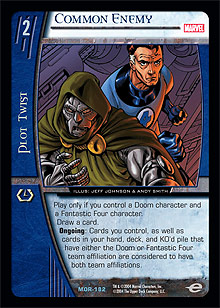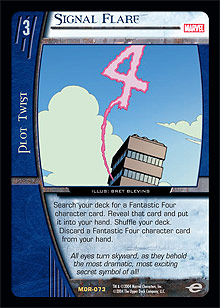The month was July, 2004. Vs. System had just been released, and people were anxious to test their skills at the game. PCQs were happening across the country. UDE had just rolled out the first of its $10K tournaments at Wizard World Philadelphia, and the game looked to be a hit. After a decent turnout in Philly, Vs. System gamers descended in droves on Columbus, Ohio, home of the Origins gaming convention.
At the time, only Marvel Origins had been released, although the Spider-Man starter deck—starring the web-slinger himself as a game-changing 7-drop—was legal for the tournament. DC Origins and the scourge of the Teen Titans were still a few weeks away. Spider-Man, The Amazing Spider-Man was going to be a force to be reckoned with in the future, but without enough team-ups, he was still a bit farfetched.
The metagame had been set by that tournament in Philadelphia. The New Brotherhood had shown itself to be a metagame wrecking ball. There were other decks to consider, of course: Lost City-based Brotherhood and Mutant Nation, Doom-based control (with or without Gamma Bomb), and Fantastic Four curve were all well-known decks. The Longshot, Rebel Freedom Fighter-based Wild Vomit, first written about by Michael Thicke, had put its pilot in the Top 8, and a deck built around A Child Named Valeria (with Four Freedoms Plaza to go search for it) had done the same for William Jensen.
But there were whispers of another deck. A secret deck. A deck that combined the best of the beefy aggro decks and the slower control decks in a build that shored up the weaknesses of both. It was talked about in hushed whispers, and the creators kept a tight lid on it until its breakout in Columbus. The secret deck was one of the first rogue decks to succeed in Vs. System, and unlike most of the others, it has stood the test of time. It would monopolize two PC Top 8s and stay relevant years after the others were gone.
Is it any surprise that it was built in West Virginia?
That deck put in its first Top 8 at Origins that year, and would be a familiar foe for the first year of Vs. System. It featured two teams that have a history of hating each other but who would, when faced with a larger threat—drawn together by a Common Enemy—combine to ensure their victory.
Anthony Justice
Common Enemy
$10K Origins 2004
Characters
4 Boris, Personal Servant of Dr. Doom
4 She-Thing, Sharon Ventura
3 Darkoth, Major Desmund Pitt
4 She-Hulk, Jennifer Walters
1 Wolverine, New Fantastic Four
4 Dr. Doom, Diabolic Genius
1 Robot Destroyer, Army
3 Thing, Heavy Hitter
1 Hulk, New Fantastic Four
1 Dr. Doom, Victor Von Doom
1 Thing, The Ever-Lovin’ Blue-Eyed Thing
1 Sub-Mariner, Ally of Doom
1 Dr. Doom, Lord of Latveria
Plot Twists
3 Savage Beatdown
4 It’s Clobberin’ Time!
4 Common Enemy
4 Signal Flare
1 Faces of Doom
3 Mystical Paralysis
3 Overload
4 Acrobatic Dodge
1 Flame Trap
Locations
4 Doomstadt
 Credit for this deck is usually given to Matt Oldaker. Anthony Justice and Ben Angel each played it to the Top 8 at Origins, which was a who’s who of top Vs. players at the beginning of the game. All eight names were familiar in 2004, even with only one $10K in Vs. System history. All were either high finishers in Vs. already (Eric Wood had Top 8’ed in Philadelphia), or had name recognition from other TCGs. Russ Pippin now works for UDE. Gabe Walls, Anthony Justice, and Michael Jacob have since joined one of the best teams in the game along with the deck’s designer.
Credit for this deck is usually given to Matt Oldaker. Anthony Justice and Ben Angel each played it to the Top 8 at Origins, which was a who’s who of top Vs. players at the beginning of the game. All eight names were familiar in 2004, even with only one $10K in Vs. System history. All were either high finishers in Vs. already (Eric Wood had Top 8’ed in Philadelphia), or had name recognition from other TCGs. Russ Pippin now works for UDE. Gabe Walls, Anthony Justice, and Michael Jacob have since joined one of the best teams in the game along with the deck’s designer.
This deck sure seems obvious in retrospect, doesn’t it? Play most of the best characters in the game (at the time) at every drop. A 6 ATK / 6 DEF 3-drop, Dr. Doom on turn 4, and Heavy Hitter on turn 5 is a monstrous curve, bigger than almost any other deck could put together at the time. This deck hit that curve with depressing (for the opponent) regularity. The theme was simple: play bigger characters than your opponent could, then prevent your opponent from dealing with them on his or her initiative.
This deck was revolutionary in two ways. First, it emphasized how important the initiative really was. It did this by taking said initiative away from the opponent on turns 4 and after if it possibly could. Reign of Terror could single-handedly swing a game on turn 4, as it would remove most of your opponent’s board and prevent him or her from stunning two of your characters. After turn 4, Mystical Paralysis would exhaust your opponent’s best character in a format still dominated by curve decks. Acrobatic Dodge could stonewall poor attacks, and the Savage Beatdown / Overload combo that would become so prevalent later would punish your opponent for pumping over a Dodge. Failing all that, sheer size made it difficult for the opponent to gain an advantage on his or her attack step.
All in all, it was extremely difficult to actually stun a Common Enemy player’s characters on his or her turn, which made it much, much easier to stun the opponent’s board when the Common Enemy player got to attack. More characters equals more attacking options, and more attacking options means more favorable attacks. It’s Clobberin’ Time turned even She-Thing into a powerhouse, and Savage Beatdown could turn even the worst attack step around.
The second revolutionary idea was the power of search. In no game before had the ability to find specific cards been as important as it has become in Vs. System. In other games, search cards were great, but often they were too expensive for an aggressive deck to use; you often had to use resources that could be used to play threats to search for cards. In Vs. System, however, plot twist search cards are essentially free. Playing Signal Flare on turn 5 doesn’t prevent you from playing Heavy Hitter that same turn. Many players were operating under the old rule that search cards were for control decks, and as a result, they were building aggressive decks like The New Brotherhood and Big Brotherhood in which search cards were nonexistent. In Big Brotherhood, for instance, 38 characters was the rule—and even then the deck missed its curve sometimes.
 In Common Enemy, however, every search card in the format that made sense for the deck was included. Four Boris and four Signal Flare were absolutes. A Faces of Doom made its way in as a card to find Doom that was searchable by Boris. As a result, the deck almost never missed the character it couldn’t afford to miss: Dr. Doom. Doom decks before this tournament had been plagued by inconsistency. With Common Enemy, however, players could run twice the number of search cards and find Dr. Doom by the fourth turn 90% of the time. If Common Enemy could hit its best curve, it had better game than every deck in the room. “Instead of playing more copies of higher drops and bad 4-drops,” reasoned the builders, “why don’t we just make sure we never miss the best curve?” That idea demonstrated the sheer power of search and consistency in this game, and it was the inspiration for many a great deck.
In Common Enemy, however, every search card in the format that made sense for the deck was included. Four Boris and four Signal Flare were absolutes. A Faces of Doom made its way in as a card to find Doom that was searchable by Boris. As a result, the deck almost never missed the character it couldn’t afford to miss: Dr. Doom. Doom decks before this tournament had been plagued by inconsistency. With Common Enemy, however, players could run twice the number of search cards and find Dr. Doom by the fourth turn 90% of the time. If Common Enemy could hit its best curve, it had better game than every deck in the room. “Instead of playing more copies of higher drops and bad 4-drops,” reasoned the builders, “why don’t we just make sure we never miss the best curve?” That idea demonstrated the sheer power of search and consistency in this game, and it was the inspiration for many a great deck.
The first Pro Circuit was only a month after this tournament, but in the meantime there were two $10Ks. In those, Common Enemy made three appearances. Both Niles Rowland and Josh Wiitanen piloted it to Top 8 finishes at the San Diego Comic Con, and Sam Gilly ran a perfect 7-0 Day 1 finish at Wizard World Chicago. The deck had obviously not gone unnoticed.
Proving that point, the deck exploded onto the scene at the first Pro Circuit. An astounding four of the Top 8 were playing it, including the eventual winner (and current UDE employee) Brian Kibler. Neil Reeves, Nick Little, and Gabe Walls also played the no-longer-secret deck into Vs. System history. DC Origins had little to offer the deck, either in playable cards or in competition. The deck featuring the sheer power of big bodies plus Dr. Doom had proven to be an unstoppable force.
Common Enemy took a back seat when Curve Sentinels became popular, and it stayed out of the limelight for over a year. It came roaring back at PC: Los Angeles in 2005, though, where it placed four more players in the Top 8 and proved that Dr. Doom never goes away—he just bides his time.
Common Enemy is one of those decks that will never truly go away. Power, flexibility, and the ability to answer threats are hallmarks of the deck, and decks with power and answers tend to make comebacks at the most opportune times. Enjoy your respite from the threat of the Fantastic Four and Doom, but keep your eyes open for decks like it in new sets and new formats. Common Enemy is a deck that combines powerful cards and a powerful strategy, and that strategy can easily be exploited by new and different powerful cards. Paying attention to the past can lead you to the powerful rogue deck of the future.
See you next time.